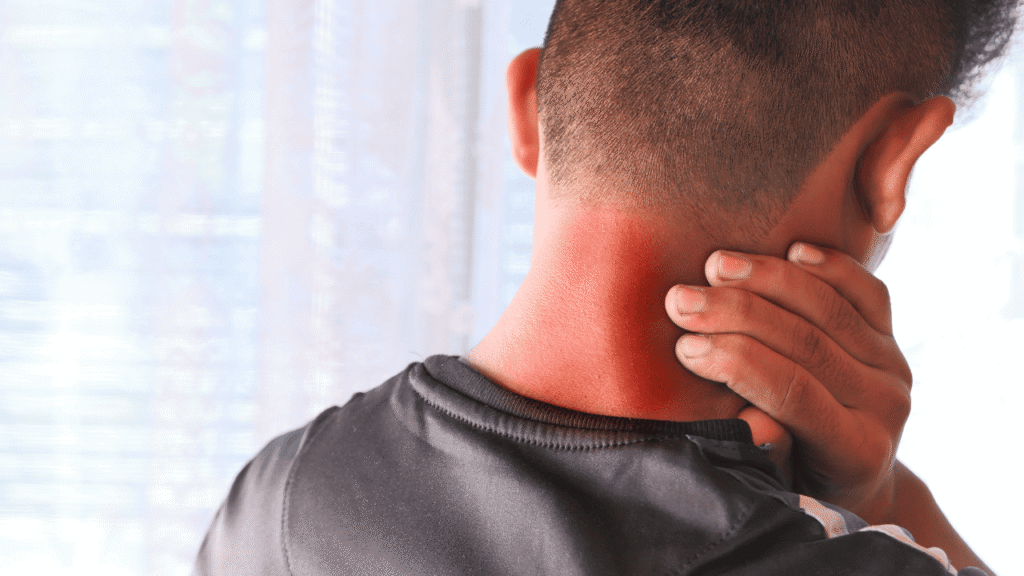What ACTUALLY Causes Back of Head Pain (Plus 8 treatments)

Dr. Tehmasip Ali
26th May, 2025
⏱︎ 7 min read

Pain in the back of your head may be due to these reasons: Poor posture, too much screentime, lack of sleep, genetic factors, dehydration, stress level, intense work, etc. In order to remove the back pain, you can perform stretching exercises, stress management, physical therapy, posture adjustment, or hydration. Now, if you want a detailed view of what causes back of head pain and how to perform these treatments for the best results, keep reading...
On This Page, You'll Learn
What Causes Back Head Pain?
Back of the head pain can have different causes depending on its intensity and location.
Below, we dive into the various types of back of the head pain and their specific causes:
1. Pain in the Neck and Back of the Head (Occipital neuralgia)
Occipital neuralgia is a condition that causes sharp, stabbing pain in the back of your head and neck. This pain may feel like an electric shock.
Common causes:
- A pinched or irritated nerve in the neck
- Whiplash from a car accident
- Sitting or sleeping with poor neck posture for long periods (like leaning your head forward while on your phone or laptop)
- Muscle tightness or inflammation from stress or tension
2. Back Head Pain often on only one side (Cervicogenic Headache)
This headache starts from problems in the neck and usually causes pain in the back of the head, sometimes spreading to the shoulders or arms.
Common causes:
- A slipped or bulging disc in your neck
- Poor posture from hunching over a desk or slouching on a couch
- Neck injuries from accidents or sports
- Sleeping on a pillow that doesn’t support your neck well
3. Pain in the Left Side or Right Side (Migraine)
You may feel a throbbing, intense pain in the back of your head that makes it hard to function. That’s Migraine.
Common causes:
- Hormonal changes (like during periods or pregnancy)
- Eating certain foods like chocolate, cheese, or processed meats
- Skipping meals or not drinking enough water
- Lack of sleep or irregular sleep schedule
- Bright flashing lights hitting your eyes
4. Pain in the Back Head While Lying Down (Cluster Headaches)
Cluster headaches are rare but intensely painful, often causing pain at the back of the head or around the eyes.
Common causes:
- Smoking cigarettes or being around smoke
- Drinking alcohol (especially red wine)
- High altitudes or flying in an airplane
- Heat or strong smells like gasoline or perfume
- Changes in your body’s sleep-wake cycle (like working night shifts or jet lag)
Looking for a General Physician in Lahore?
At AHMC, we provide you with one of the top MBBS general physicians in the city.

8 Treatments to Remove the Back Head Pain
1. Stretching Exercises
How:
- Slowly tilt your head forward, then backward.
- Gently turn your head side to side.
- Do shoulder rolls and neck stretches by pulling your ear toward your shoulder.
- Hold each stretch for 15–30 seconds. Repeat 2–3 times daily.
Why it works:
Stretching releases tension in tight neck and upper back muscles, which are often the source of back head pain. It also improves blood flow and posture, both of which help reduce pain and prevent it from coming back.
2. Cold and Heat Therapy
How:
- Apply a cold pack (like a bag of frozen peas wrapped in a towel) to the back of your head for 10–15 minutes.
- Switch to a warm towel or heating pad for another 10–15 minutes if your muscles feel tight.
- Use 2–3 times a day or when the pain flares up.
Why it works:
Cold helps numb sharp pain and reduce swelling from nerve irritation. Heat relaxes tight muscles and improves blood circulation, which eases the dull, throbbing pain often caused by tension.
3. Massage Therapy
How:
- Use your fingers to gently massage the base of your skull, neck, and shoulders in circular motions.
- Or get a professional massage focused on neck and upper back tension.
- You can also use a massage tool or foam roller.
Why it works:
Massage loosens up tight muscles and improves circulation, which reduces pain in the back of the head.
4. Over-the-Counter Pain Relievers
How:
- Take medications like acetaminophen (Tylenol) or ibuprofen (Advil) as directed on the label.
- Don’t take them on an empty stomach, and avoid overuse.
Why it works:
These medications reduce inflammation and block pain signals sent to your brain. They work well for short-term relief from mild to moderate pain.
5. Physical Therapy
How:
- Visit a licensed physical therapist.
- They’ll teach you neck and shoulder strengthening exercises and guide you on posture correction.
- You’ll usually do sessions weekly, with at-home exercises in between.
Why it works:
Strengthening weak muscles and correcting movement patterns helps reduce recurring pain, especially if it’s caused by poor posture or nerve irritation in the neck.
6. Correct Your Posture
How:
- Keep your back straight and shoulders relaxed.
- When sitting, make sure your screen is at eye level and your feet are flat on the floor.
- Sleep with a supportive pillow that keeps your neck aligned.
Why it works:
Bad posture strains your neck and upper back muscles, leading to tension and pain at the back of your head. Fixing posture relieves and prevents that pressure.
7. Hydration and Diet Changes
How:
- Drink at least 8 glasses of water daily.
- Avoid skipping meals.
- Eat foods rich in magnesium (like spinach, nuts, bananas) and avoid processed foods and excess sugar.
Why it works:
Dehydration and poor nutrition can trigger tension headaches and migraines. Staying hydrated and eating right support muscle function and brain health, both key for pain prevention.
8. Stress Management
How:
- Try deep breathing for 5–10 minutes a day.
- Practice yoga or meditation using free apps or videos.
- Set time aside to relax and unwind from screens.
Why it works:
Stress tightens muscles, especially in the neck and shoulders, which often leads to back of head pain. Managing stress helps calm your nervous system and reduces that physical tension.
Loving the Blog So Far?
We post daily health tips like this on our Instagram. Make sure you don't miss them out!
When to Visit a Doctor
While most types of back of head pain can be managed with self-care, there are times when medical intervention is necessary. Consider seeking professional help if:
- Your back of head pain lasts for more than a week.
- The pain is severe or keeps you from doing daily activities.
- You experience sudden, intense pain or a headache that’s different from previous headaches.
- You have additional symptoms like fever, neck stiffness, or difficulty concentrating.
Final Thoughts on Back-of-the-Head-Pain
If you’re experiencing back-of-the-head pain, the key to relief is identifying the underlying cause. Whether it’s due to tension headaches, poor posture, or stress, there are plenty of ways to alleviate the discomfort. For example, stretching exercise, cold therapy, massage therapy, posture correction, and hydration.
But Remember,
If your pain is severe, persistent, or accompanied by other concerning symptoms (for example, fever), please don’t hesitate to consult a general physician.


Contact Now:

0309-9339981
© 2025. All rights reserved.
© 2025. All rights reserved.
